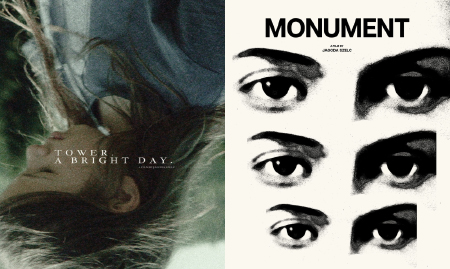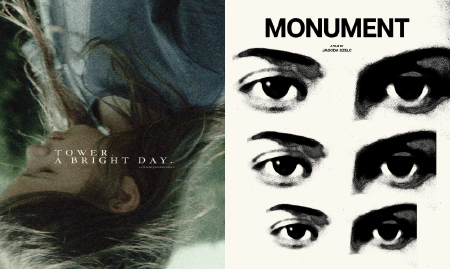Tower. A Bright Day./Monument (Blu-ray Review)

Director
Jagoda SzelcRelease Date(s)
2018 (September 26, 2023)Studio(s)
Various (Yellow Veil Pictures/Vinegar Syndrome)- Film/Program Grade: See Below
- Video Grade: See Below
- Audio Grade: See Below
- Extras Grade: A
Review
In director Jagoda Szelc’s first feature-length film, Tower. A Bright Day., a protective woman has raised her young niece in the countryside as her own daughter. When the woman’s sister suddenly returns, it triggers a sense that she may be back to reclaim her offspring or to implement even more ominous plans.
The film begins as Kaja sits squashed into the back seat of a car on a hot day as she and her brother Andrzej and his family travel toward her sister Mula’s home in the country for a Holy Communion celebration. When they arrive, Mula pulls Kaja aside and formally delivers a list of rules Kaja must follow. Mula is visibly nervous, and reads the rules off a piece of paper where she has written them down previously. Kaja must not talk about where she has been in her absence. She must be “normal,” and most of all, she must not let little Nina or the local villagers know that Kaja is, in fact, Nina’s mother. Raised by Mula and her husband Michal as their own daughter, Nina must not discover that she is Kaja’s child.
Mula’s patience is tested with many strange occurrences around town and inside her own home since Kaja’s arrival. They don’t seem to contribute to the story as a whole, but they are incorporated so frequently within the story that they momentarily shift focus. Tension escalates as the story progresses, suggesting but never explicitly revealing the cause of Mula’s unease and the palpable chilly atmosphere. The film keeps the viewer guessing as to why this tension exists and what the actual backstory is between Kaja and Mula. Director Jagoda Szelc keeps things confusing and often difficult to follow, yet creates an encompassing sense of unease. There’s ultimately an explanation, but the viewer must decide whether it was worth the two-hour wait.
Tower. A Bright Day. was captured digitally by director of photography Przemyslaw Brynkiewicz in the aspect ratio of 2.35:1. Detail is very good, but some scenes are somewhat hazy, suggesting the sun-drenched setting of Mula’s backyard. The film opens with overhead shots of a lone car leaving a city and entering a lush mountainous rural area. Much of the film is shot outdoors under sunny skies, yet despite the bright spring or early summer day, there’s a sense of something not being quite right. The color palette is dominated by the various shades of green in the trees and large expanses of grass. Even a lake’s water reflects the trees, taking on a green hue as well. The children at a communion ceremony wear white. Interiors of the house are darker. Detail in rock formations, pores on faces, wallpaper in the children’s room, and a trampoline are nicely delineated. The editing establishes a rhythm that is broken by occasional jump cuts, creating a jarring feel that interrupts the leisurely pace. Szelc combines realistic narrative with an unsettling sense of anxiety.
Two soundtrack options are included: Polish 5.1 and 2.0 DTS-HD Master Audio. English subtitles appear at the bottom of the screen. Dialogue is clear throughout and more plentiful than in Monument. Sound effects include children splashing in the lake, a dog barking, wind rustling through trees, a microphone’s feedback, and sheets of plastic gently blowing. The music by Teoniki Rozynek is eerie without being overly obvious, and suggests that there’s more to the family get-together than what we see.
TOWER. A BRIGHT DAY. (FILM/VIDEO/AUDIO): B/A-/B
Jagoda Szelc’s second film, Monument, defies the rules of traditional cinema. The script doesn’t follow the typical narrative beginning-middle-conclusion structure. Nor does it rely on typical horror-movie devices. Rather, its unsettling drama derives from a claustrophobic setting, overpowering atmosphere, and surrealistic sequences.
A group of young adults fall asleep on a bus and wake up at night in the parked vehicle, cold and exhausted from the long ride, at a secluded resort where they are to begin internships. They are met by the stern, officious manager (Dorota Lukasieswicz). She immediately strips them of their individualism by designating them as either “Girl” or “Boy” and tells them they will learn all the tasks required of service employees. They will be assigned to groups or pairings focused on specific tasks. Three women will clean customers’ rooms and a pair of men will work in the laundry. A team will clean the kitchen, another will clean a mysterious pedestal, a young woman will work in the spa, and a pair will be outside organizing trash. The menial work is mundane and physically hard. As the interns go about their work experience, they start to exhibit disturbing behavior that they can’t seem to control.
Monument is intentionally ambiguous. It can lead to frustration on the part of the viewer but is nonetheless intriguing. What’s really going on here? That question keeps us involved as we wait to learn how the events tie together. Szelc employs uncertainty to evoke audience anxiety, relying on our fears of the unknown. It’s as if we’ve been placed into a Twilight Zone-like scenario. We feel disoriented, confused, and uneasy. There are several creepy sequences bordering on the bizarre as each segment tracks the psychological erosion of its characters. There’s no sense of time, which further disorients the characters and the audience. There’s a payoff at the end that explains much of what we’ve seen earlier, but its effect depends on whether you feel it justifies the wait. It’s a cold film, from the icy demeanor of the manager to the wintery, bleak setting, and it requires the kind of patience that may not be for everyone.
Monument was also captured digitally by director of photography Przemyslaw Brynkiewicz in the aspect ratio of 2.35:1. The opening scene of the interns in the bus has a blue cast, suggesting chilliness. Lighting in the resort is dim when the interns first encounter the manager but brightens at a lavish catered affair in which they must prove themselves. A character in the basement is silhouetted by a single light from the doorway above the stairs. Corridors have a greenish hue. Lighting and camera compositions contribute to atmosphere. Exterior night scenes create a sense of foreboding.
There are two soundtrack options: Polish 5.1 and 2.0 DTS-HD Master Audio. English subtitles appear at the bottom of the screen. There is no option to watch the film in the original Polish without subtitles. Dialogue is clear throughout. There isn’t a lot of odd and unexplained sounds to correspond to the gloomy visuals and may have been an opportunity missed. The climactic ritual involves chanting, stamping, moaning, and other guttural sounds, giving the ceremony a primitive, almost tribal feel. The sound level rises as the participants work themselves into a frenzy.
MONUMENT (FILM/VIDEO/AUDIO): B-/A/B
The 2-Disc Blu-ray set from Yellow Veil Pictures includes both films and the following bonus materials:
DISC ONE (TOWER. A BRIGHT DAY.)
- Introduction by Director Jagoda Szelc (:53)
- Behind the Scenes Slideshow (7:23)
- Behind the Scenes Rehearsal (8:38)
- Animatic to Scene (2:20)
- Punkt Wyjścia Nowa Avi (18:19)
- Aposiopesis (6:29)
- Such a Landscape (22:51)
Behind the Scenes Slideshow – Still production photos of characters and scenes are shown.
Behind the Scenes Rehearsal – The casting process is documented in this brief featurette. Footage of the cast rehearsing is included.
Animatic to Scene – Animated representations of shots in the opening sequence are shown on the left while corresponding filmed scenes appear on the right.
Punkt Wyjścia Nowa Avi – Aneta wound up in prison for murder at age 19. Nine years later, her daily routine takes her from behind the walls of the prison to a care home for the elderly. One of the residents, Helena, has been ill ever since infancy. Helena is fascinated by Aneta, believing Aneta has everything she could want, and Helena asks her about her life. A test awaits Aneta and help will come from Helena.
Aposiopesis – A girl prepares herself for a difficult moment. In classical Greek, “aposiopesis” means becoming silent. Today we use it as a figure of speech wherein a sentence is deliberately broken off and left unfinished.
Such a Landscape – Lacking a traditional plot, this non-linear story follows the path of emotions and sensations. Based on actual events, the film shows five acts—Miracle, Atonement, Regret, Prayer, Forgiveness—that might help us overcome the fear of death.
DISC TWO (MONUMENT)
- Introduction by Director Jagoda Szelc (:40)
- Interview with Director Jagoda Szelc (19:48)
- Storyboard to Scenes:
- Scene 1 (4:02)
- Scene 21 (6:51)
- Scene 32 (2:53)
- Behind the Scenes Slideshow (2:27)
- Moodboard Slideshow (2:17)
Interview with Director Jagoda Szelc – The director was interested in changing the genre from drama to thriller. She speaks about the genesis of her film Tower. A Bright Day. The script was based on a rehearsal (clips from Tower. A Bright Day. are shown). She speaks about the limited budget, requiring her to use one set and only a few actors. The budget for Monument was $25,000 and it was shot over 23 days and edited in ten days. She had to use existing locations near each other to save on gas. The climactic ritual ceremony was shot in a single take in documentary style. Szelc speaks about working with an ensemble cast made up of film students about to graduate. She equates a diploma with being born into a regular life.
Storyboard to Scenes – Storyboards for three scenes are shown on the left side of the screen with corresponding scenes in the film on the right.
Behind the Scenes Slideshow – Still production photos of characters and scenes are shown.
Moodboard Slideshow – This series of illustrations and photographs conveys atmosphere. Sets are dramatically lit, parts of rooms are depicted, eerily illuminated actors are highlighted, with hazy exteriors, foggy streets and apartment building exteriors emitting an often ominous vibe.
Booklet – The 16-page booklet includes the critical essay One Two Three: The Witch Is Watching Thee about Jagoda Szelc’s two feature films. Also included are eight pages of color photos.
Both Tower. A Bright Day. and Monument border on the surreal because of the strangeness, sense of disorientation, and peculiar behavior that permeate their stories. Both are extremely subtle and present questions that drive suspense and make the viewer wonder what’s really going on. Director Jagoda Szelc plants clues along the way so that we know that the stories we are watching don’t immediately reveal all. Both films rely more on our emotional reaction to their oddness than to a traditional plot.
- Dennis Seuling

